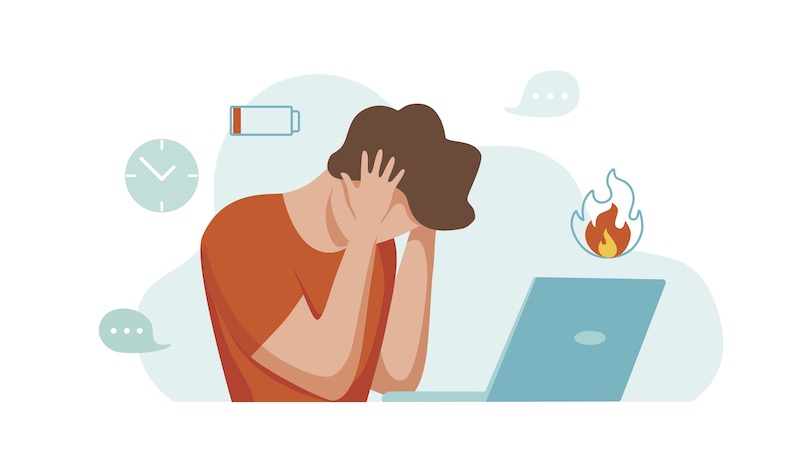The difference between stress and burnout – and why it matters
Although stress can be experienced in any situation, burnout relates exclusively to the workplace. With 88% of UK employees experiencing some level of burnout between 2020 and 2022, it is important for employers to understand what this is and what it means for businesses.
Stress is an automatic response, defined by the World Health Organization as “a state of worry or mental tension caused by a difficult situation. Stress is a natural human response that prompts us to address challenges and threats in our lives.”
Stress depends on the individual. What some people find stressful others may not. It depends on a whole host of factors including personal resilience, how many perceived and actual stressors are in play across different areas of life, and what actions are or are not taken to reduce stress. But, ultimately, it is any type of change that causes physical, emotional, or psychological strain.
Burnout is not a medical condition, but an occupational phenomenon. It has recently been included in the revised International Classification of Disease, which defines it as “a syndrome conceptualised as resulting from chronic workplace stress that has not been successfully managed.”
It is characterised by three symptoms/dimensions:
- feeling of energy depletion or exhaustion
- increased mental distance from one’s job, or feelings of negativism or cynicism related to one’s job
- reduced professional efficacy
The risk of burnout can be associated with poor health, lower productivity, increased accidents and sickness rates. Management standards, as set by the Health and Safety Executive, include:
- Demand: excessive workload
- Control: lack of control, autonomy or decision making
- Support: lack of support from colleagues, line managers
- Relationships: difficult workplace relationships
- Role: perceived unfairness/conflict of personal values with occupational values
- Change: job insecurity.
When stress is good
Not all stress is negative. In some cases, it can help people perform well. In a work environment, it can be stress that helps an employee meet a tight deadline or nail an important client presentation.
Too little stress can lead to apathy, lethargy, and low mood, which can lead to other health conditions such as cardiovascular disease and depression.
How we perceive the stress, whether positive or negative, depends on the individual.
A precursor to ill health
Over the last four year, HCML has completed more than 34,000 employee mental health assessments. Stress has been the main factor attributed to mental ill health in 15% of people.
Stress and anxiety share many of the same physical and psychological symptoms and will vary for everyone. Physical symptoms can include back pain, digestive health issues, poor sleep, and weight changes. Psychological symptoms can include low mood and depression, apathy, impaired memory function, poor concentration and frustration.
These changes can negatively affect personal life, but also work, with reduced performance, negative behaviour and long-term sickness.
Recognising and addressing the causes of stress and providing support in the workplace is key to mitigating further ill health and the risk of sickness absence.
Of the employees presenting with mental health conditions, 95% were not meeting activity guidelines, 70% were overweight, 60% regularly had less than 6 hours sleep and 38% perceived work to be a contributing factor.
There are a several underlying factors which can contribute to ill-health that employers can look to start addressing, whether it’s supporting employees with good nutrition, helping them be more active, or understanding how to spot the signs of stress at work and providing interventions.
Burnout and lonmg-term stress
Burnout applies exclusively to work and is associated with ongoing, long-term work stress, where there is little opportunity for proper recovery. Burnout can affect all areas of life, with people having little interest in the things they once did, and may result in avoiding or isolating oneself from friends and family, increasing their risk of depression.
Burnout is not sudden – it is often a gradual change. A good way to describe the feeling is when you no longer have the capacity to engage or care. It is important for managers and colleagues to be alert to the signs of burnout and offer help and support.
How to spot the signs of employee burnout
A sign of burnout is a fall in work performance, but other behaviours or emotions can signal that something may not be quite right.
These behaviours or emotions can include:
- Social isolation in the workplace: missing meetings, not replying to emails, disengaging from activities.
- Taking more time off than usual, with little warning.
- Struggling to meet deadlines.
- A change in attitude towards work which may include increased cynicism.
- Showing frustration or suddenly having a short temper.
- A lack of motivation.
- A loss of confidence.
- Forgetfulness and poor concentration.
Supporting employees feeling burnout
Supporting employees’ health and wellbeing before they hit burnout is the best approach. A culture of health and wellbeing at work lets employees know that they can talk freely about how they are feeling and get help before matters get worse, without fear of being penalised in any way.
The long-term impact of providing support far outweighs short-term intervention. Over four years, we found that when supported, 47% of people off sick with mental health conditions returned earlier than the clinical average. This represents a saving of £7.1 million. Of these, 38% were supported with a non-clinical approach of self-help interventions.
There will be people who need clinical intervention such as talking therapy, but there is much more that businesses can do to support workers experiencing burnout, including:
- Psychological risk assessment.
- Regular one-to-ones to ensure employees feel they have ‘meaningful work’ that keeps them motivated.
- Encouraging employees to take annual leave.
- Training line mangers to understand and support employees with mental health conditions.
- Employee programmes on sleep, nutrition, and physical activity.
- Using employee health and wellbeing data to spot trends and identify risks.
While stress can be related to a variety of lifestyle factors, burnout is specifically linked to work. But a culture of health and wellbeing can help mitigate both.
Supplied by REBA Associate Member, HCML
HCML is a health and wellbeing provider, offering integrated and personalised healthcare solutions.








